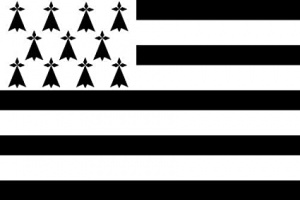Language/Breton/Grammar/Adjectives
Hi Breton learners! 😊
In today's lesson, we will be discussing adjectives in the Breton language. Adjectives are words that describe nouns and pronouns. They can be used to express a variety of meanings, such as size, shape, color, age, and more. Knowing how to use adjectives correctly is essential for speaking and writing Breton fluently.
Formation of Adjectives
Adjectives in Breton are formed by adding suffixes to the root of the word. The suffixes depend on the gender and number of the noun or pronoun being described. For example, the adjective "big" is "braz" in Breton. To make it agree with a masculine singular noun, the suffix "-añ" is added, making it "brazañ". To make it agree with a feminine singular noun, the suffix "-e" is added, making it "brazeg". To make it agree with a masculine plural noun, the suffix "-où" is added, making it "brazoù". To make it agree with a feminine plural noun, the suffix "-ed" is added, making it "brazed".
Position of Adjectives
In Breton, adjectives usually come after the noun they are describing. For example, the phrase "big house" would be "ti braz" in Breton. However, there are some exceptions to this rule. For example, when describing a person, the adjective usually comes before the noun. For example, the phrase "happy person" would be "den laouen" in Breton.
Adjective Agreement
When using adjectives in Breton, it is important to make sure that they agree with the noun or pronoun they are describing. This means that the adjective must have the same gender and number as the noun or pronoun. For example, if you are describing a feminine singular noun, the adjective must also be feminine singular. If you are describing a masculine plural noun, the adjective must also be masculine plural.
Adjective Endings
The endings of adjectives in Breton depend on the gender and number of the noun or pronoun being described. For example, the adjective "big" is "braz" in Breton. To make it agree with a masculine singular noun, the suffix "-añ" is added, making it "brazañ". To make it agree with a feminine singular noun, the suffix "-e" is added, making it "brazeg". To make it agree with a masculine plural noun, the suffix "-où" is added, making it "brazoù". To make it agree with a feminine plural noun, the suffix "-ed" is added, making it "brazed".
Adjective Comparison
Adjectives in Breton can also be compared using the suffixes "-oc'h", "-añ", and "-añoc'h". The suffix "-oc'h" is used to compare two things, while the suffixes "-añ" and "-añoc'h" are used to compare three or more things. For example, the adjective "big" is "braz" in Breton. To compare two things, the suffix "-oc'h" is added, making it "brazoc'h". To compare three or more things, the suffix "-añ" is added, making it "brazañ".
Conclusion
In this lesson, we discussed adjectives in the Breton language. We learned how to form adjectives, where to place them in a sentence, and how to make sure they agree with the noun or pronoun they are describing. We also learned how to compare adjectives using the suffixes "-oc'h", "-añ", and "-añoc'h".
If you have any questions, please ask them in the comments section below.
Feel free to edit this wiki page if you think it can be improved. 😎

